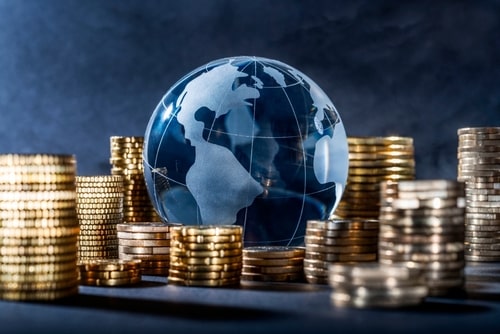The gold market is seeing a strong rally during the first month of the year, driven by the changing macro outlook, geopolitical tensions, and increased demand. And more analysts are looking into central bank purchases for the reasons why.
The fear of sanctions and the growing trend around de-dollarization are some of the top reasons why more countries are looking at gold again. This is especially the case with countries that want more freedom and flexibility when trading goods to bypass the U.S. dollar, which some view as having strings attached, according to analysts.
“Gold is a decentralized asset. No one person is controlling it. No one government or person is controlling the price. Meanwhile, the U.S. dollar is centralized. It is controlled by government policies,” Frank Holmes, CEO of U.S. Global Investors and executive chairman of HIVE Blockchain, told Kitco News.
Central banks began looking at gold again during the second half of last year, taking the opportunity of the precious metals’ low prices to buy a total of nearly 400 tons in the third quarter of 2022. This marked a 300% jump from the same period a year ago, according to the World Gold Council (WGC) report.
“There’s something else going on that central banks from all over the world would buy gold when interest rates are surging. Historically when interest rates are surging, gold takes it on the chin, and central banks are net sellers, not buyers,” Holmes said. “[This new trend] says that there’s a geopolitical development that other central banks are recognizing. They have to have decentralized assets on their balance sheet.”
Based on the latest data, central banks purchased 673 tons of gold in the first three quarters of last year, outpacing total annual purchases since 1967 — when the U.S. dollar was still backed by gold. All eyes are now on the WGC’s fourth-quarter report, which will be released at the end of January with updated numbers for the year.
“Recent months have seen many central banks stockpiling gold – perhaps because of rising inflation, but it could also be part of a wider strategy to help them become sanction-proof,” Sukhi Jutla, co-founder & COO at MarketOrders, told Kitco News.
Some analysts pointed to mystery buyers behind this surge. TD Securities said countries like China are driving the gold price at the moment. “Armed with a flows-based approach, we present strong evidence that behemoth Chinese and official sector purchases may have single-handedly catalyzed a $150/oz mispricing in gold markets,” the bank’s senior commodity strategist Daniel Ghali said in a report last week.
Confirming this theory, China reported buying an additional 30 tons of gold in December. This follows its November purchase of 32 tons of gold, which was the People’s Bank of China’s first officially recorded purchase since September 2019. China’s gold reserves now total 2,010 tons.
Many analysts see that trend continuing in 2023. “Gold has become an attractive hedge against sanctions risk for central banks at risk of such penalties. While there are limitations to gold’s usefulness compared to, say, U.S. Treasuries, its unique appeal is found in its physical form, unquestioned value, and the ability to store bars in national vaults, safe from foreign seizure,” Daniel McDowell, associate professor of political science at Syracuse University, told Kitco News.
Focus on geopolitics
Geoeconomic confrontations are one of the top three risks identified for the next two years, according to a survey released by the World Economic Forum last week.
Top of mind for some countries are sanctions, fears of getting cut off from the SWIFT system, which is what happened to Russia, getting their forex reserves frozen, or being limited in their use of U.S. dollars when trading.
“Central banks worried about the potential for the dollar or euro-based assets to be frozen find [gold] appealing. They are willing to trade off some liquidity in their portfolio for that extra security,” McDowell explained.
The unprecedented Western sanctions introduced against Russia for its actions in Ukraine have frozen around half of Moscow’s $640 billion reserves. Last year, Moscow accused Western countries of using sanctions to steal its foreign exchange reserves.
Since then, there have been many changes on the geopolitical front to move away from U.S. dollars. And not just from Russia.
Russian Foreign Minister Sergey Lavrov said at a press conference this week that half of the trade turnover between Russia and China is being settled in national currencies. Lavrov added that Russia and China are working on cutting their reliance on “Western instruments” without “moves that could undermine our relations” and harm market players.
The trade turnover between the two countries broke a record and reached around $200 billion by the end of 2022. When commenting on this, Lavrov added that “soon” the trade turnover will be calculated in rubles and yuan, not the U.S. dollar.
This goes beyond the Russia-Ukraine conflict
Other developments include Saudi Arabia stating it is open to discussing trade in currencies other than the U.S. dollar. Recently, Saudi Arabia has been working to increase cooperation with China.
“It’s not just the war between Russia and Ukraine. It’s the geopolitics of China, which has been for five years trying to get the Saudis to buy oil with yuan,” Holmes pointed out. “It’s part of the strategy. China is creating a currency that’s outside of the SWIFT system to stop overreaching from U.S. government agencies. That is significant because China is the biggest buyer of oil.”
The Chinese buying more gold could be connected to all of this, he added. “China surprised everyone before Christmas with how much they bought. They haven’t reported for three years.”
Aside from China, there are other creative solutions popping up that involve blockchain and gold. For example, Iran and Russia are reportedly working together to create a new stablecoin backed by gold.
One way or another, gold seems to play a role in this new world that is leaning away from globalization and more towards fragmented, bilateral trade deals.
“We are and will continue to see more nations use gold as a trading mechanism, or in some cases to back other trading mechanisms – whether they be local/regional currencies or digital assets,” William Stack, financial advisor at Stack Financial Services LLC, told Kitco News.
One of the trading blocs to watch when it comes to the potential use of gold when trading is the BRICS, Stack pointed out.
“Part of the continuing pressure to reintroduce gold as a trading or backing mechanism is related to the BRICS trading bloc, which has been expanding. Unlike the G-7 or G-20 group of nations which is an exclusive club, the leaders of the BRICS have made overtures to any nations interested in joining. Not surprisingly, some of those nations warming up to BRICS have been previously (or currently) sanctioned by Western nations,” he said. “Overtures by BRICS nations have included an opportunity for full membership, regardless of the amount of dollar-based debt a nation may owe. In other words, they can become trading partners in the new gold and regional currency-based network of BRICS, without regard to debt or sanctioning status in the Western-based financial system.”
In a year of “unthinkable macro scenarios,” Credit Suisse’s Zoltan Pozsar said it is not improbable for gold to double to $3,600 an ounce if Russia responds to G7’s oil price cap by accepting gold for crude.
While this outcome might sound out of this world, it is not that far-fetched given some of the geopolitical and macroeconomic surprises from this year, Pozsar said in a note titled ‘Oil, Gold, and LCLo(SP)R.’
“Crazy? Yes. Improbable? No. This was a year of the unthinkable macro scenarios and the return of the statecraft as the dominant force driving monetary & fiscal decisions,” Pozsar wrote.
Holmes told Kitco that he still sees gold passing $4,000 an ounce in his long-term forecast for the yellow metal.
Source: KITCO

